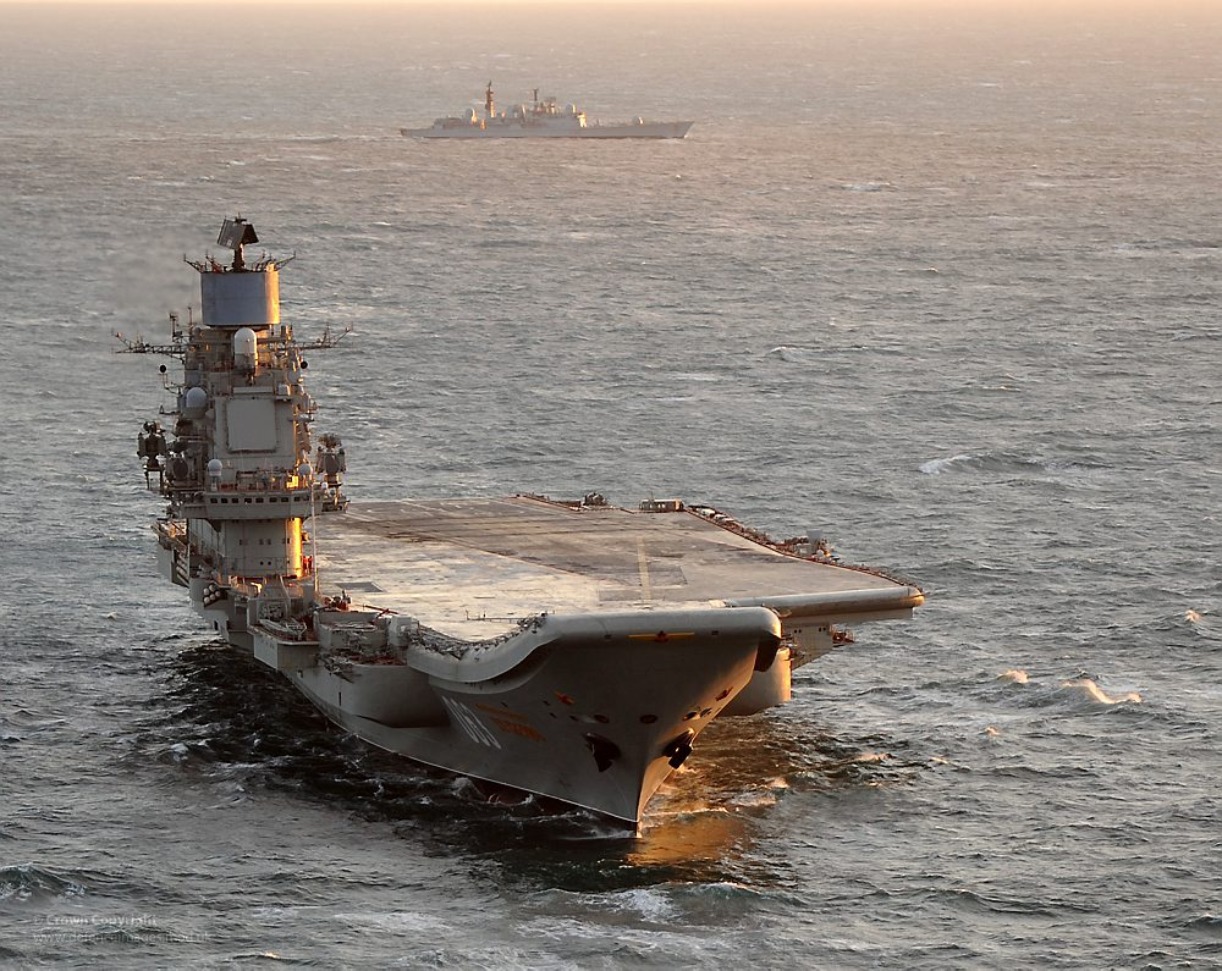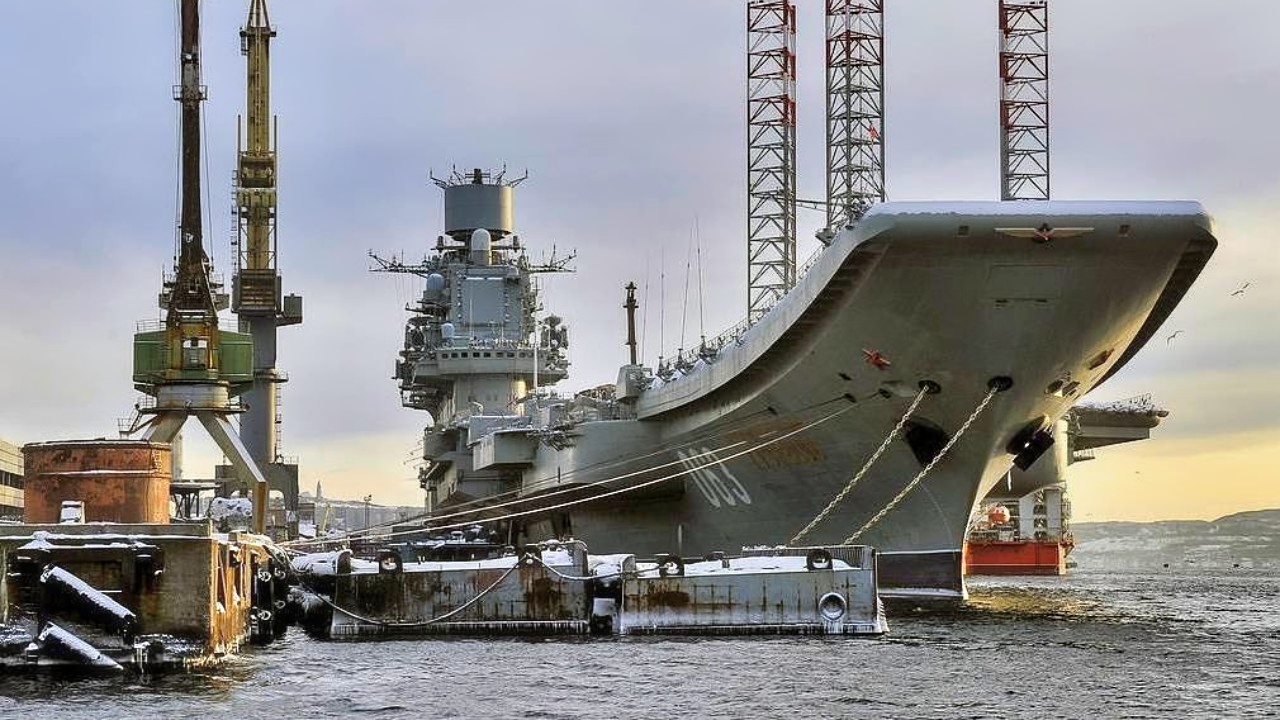Admiral Kuznetsov: Russia's Last Aircraft Carrier Was a Crazy 'Missile Farm'
Russia’s only aircraft carrier, the Admiral Kuznetsov, is a unique hybrid vessel, combining aircraft-launching capabilities with a formidable array of missile systems. Designed to deploy heavy anti-ship missiles like the P-700 Granit, the Kuznetsov could strike from 350 miles away without needing its aircraft.
What You Need to Know: Russia’s only aircraft carrier, the Admiral Kuznetsov, is a unique hybrid vessel, combining aircraft-launching capabilities with a formidable array of missile systems. Designed to deploy heavy anti-ship missiles like the P-700 Granit, the Kuznetsov could strike from 350 miles away without needing its aircraft.

-It also carried substantial air defenses, including Gauntlet surface-to-air missiles and close-in weapons systems.
-Despite its potential, the Kuznetsov has been plagued by mechanical failures and accidents, leaving it in drydock since 2018. As a result, Russia's naval power projection remains limited without a functional carrier.
How Admiral Kuznetsov’s Missile Arsenal Made It a Unique Naval Threat
Russia’s only aircraft carrier, the Admiral Kuznetsov, was originally designed to deploy a “missile farm” that was more powerful than the airplanes it launched from its deck.
The downsides of the Kuznetsov have been chronicled substantially .
It will be under repair until 2024 (but likely longer) and has endured numerous mechanical and construction problems.
The Kuznetsov, however, had it seen battle, could likely have held its own with its array of carrier-killing missiles.
It had numerous bays and tubes for launching weapons that could support a carrier battle group with several ships that also had deadly missiles. Let’s take a look at how the Russian navy armed this carrier.
Not Your Normal Aircraft Carrier
The Kuznetsov could be seen as a “heavy missile and aviation cruiser” that could also carry airplanes rather than just a normal aircraft carrier. Tyler Rogoway, chief editor for The Warzone, described the following armaments that the Kuznetsov featured. There were 24 rotating launch tubes onboard for the Gauntlet surface-to-air missile. The Kuznetsov had 192 of these missiles.

Heavy Anti-Aircraft Defenses
For last-ditch air defenses, Rogoway wrote that the carrier boasted close-in weapon systems for the enemy airplanes and incoming missiles that made it past the SAMs. In this department, the carrier used six AK-630 cannons and eight Kashtan close-in weapons systems.
Enemy submarines would have noticed that the Russian carrier was equipped with UDAV-1 sub-killing rockets that could also be utilized against torpedoes.
Admiral Kuznetsov: This Thing Was a Missile Truck
Kuznetsov served as a missile truck for more munitions that could destroy enemy targets on sea. P-700 Granit “Shipwreck” missiles adorned the carrier. The Granit can be configured for triple use for nuclear, conventional, and thermobaric warheads. The Granit has a high explosive conventional payload of 1,600 pounds.
Lead Launcher for a Swarm of Missiles
The idea for the Kuznetsov missile farm approach was that it could challenge an American carrier battle group by staying out of range of enemy ships and airplanes and launch the sea skimming anti-ship missiles from 350 miles away. It could then fight without even using its own airplanes launched from the carrier.
These missiles could swarm and overwhelm a ship’s defenses by sheer numbers.
This Was the Leader of a Multi-ship Contingent
Remember, the Kuznetsov would be sailing in its own battle group which means other Soviet destroyers, frigates, cruisers, and submarines would also be sending offensive anti-ship missiles that could overwhelm American ships.
Not A Large Aircraft Force
The ship’s aircraft group was made up of 12 Su-33 or MiG-29K. There was room for a large number of helicopters including two Ka-27S, 18 Ka-27PLO, and four Ka-31 rotary wing aircraft. The fighters launched from a 12-degree ski jump at the bow instead of catapults.
Because of this limitation, the fighters could not carry heavy loads of ordnance. No electronic warfare airplanes were on board. Airborne early warning was done by helicopter which reduced the range of aerial attacks that could jam enemy radar.
Disaster After Disaster
Thankfully for the United States and NATO, the Kuznetsov was cursed. It had a floating dock accident when a 70-foot crane fell on the deck in 2018. One worker died and four were injured. This left a 20-foot hole above the water line. And then the ship suffered a fire in 2019 from a welding accident. The blaze was not contained until a day later—after it killed two and wounded 14. And it recently just suffered another fire as 2022 came to a close.
How Do We Classify It?
So, was the Kuznetsov a carrier or a large missile cruiser that happened to have aircraft?
It should be seen as a hybrid ship for supporting a contingent of other surface vessels and submarines. The Soviet and later the Russian navy envisioned a stand-off role for the missile farm, knowing that its airborne combat role from fighters was going to be limited in offensive capability. Now with it in drydock for an extended period, the Russians are without a carrier and not able to project power by sea. This makes the Russian navy limited in scope. But at one time, the Kuznetsov could have done much damage with its ship-killing missiles.
The U.S. Navy and surface fleets from various NATO allies breathed a sigh of relief that it never had to go up against a carrier battle group from the Russian or Soviet navy in its heyday.
Expert Biography
Dr. Brent M. Eastwood is the author of Humans, Machines, and Data: Future Trends in Warfare. He is an Emerging Threats expert and former U.S. Army Infantry officer. You can follow him on Twitter @BMEastwood. He holds a Ph.D. in Political Science and Foreign Policy/ International Relations.
From the Vault
Russia Freaked Out: Why the U.S. Navy 'Unretired' the Iowa-Class Battleships
Battleship vs. Battlecruiser: Iowa-Class vs. Russia's Kirov-Class (Who Wins?)


